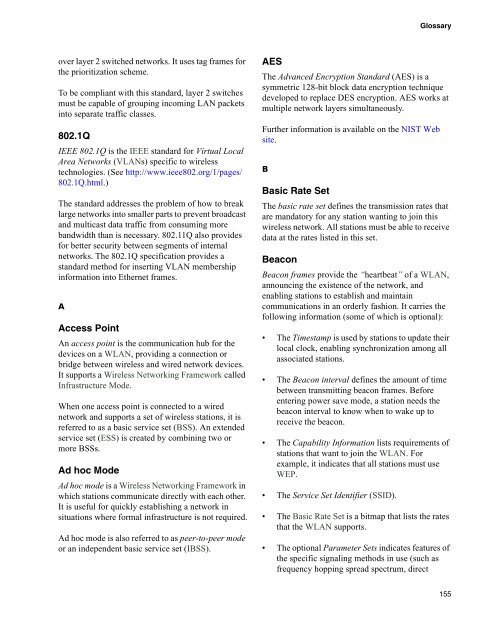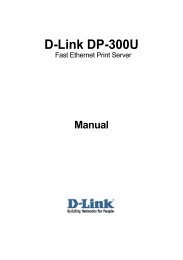Unified Access Point (AP) Administrator's Guide
Unified Access Point (AP) Administrator's Guide
Unified Access Point (AP) Administrator's Guide
You also want an ePaper? Increase the reach of your titles
YUMPU automatically turns print PDFs into web optimized ePapers that Google loves.
over layer 2 switched networks. It uses tag frames for<br />
the prioritization scheme.<br />
To be compliant with this standard, layer 2 switches<br />
must be capable of grouping incoming LAN packets<br />
into separate traffic classes.<br />
802.1Q<br />
IEEE 802.1Q is the IEEE standard for Virtual Local<br />
Area Networks (VLANs) specific to wireless<br />
technologies. (See http://www.ieee802.org/1/pages/<br />
802.1Q.html.)<br />
The standard addresses the problem of how to break<br />
large networks into smaller parts to prevent broadcast<br />
and multicast data traffic from consuming more<br />
bandwidth than is necessary. 802.11Q also provides<br />
for better security between segments of internal<br />
networks. The 802.1Q specification provides a<br />
standard method for inserting VLAN membership<br />
information into Ethernet frames.<br />
A<br />
<strong>Access</strong> <strong>Point</strong><br />
An access point is the communication hub for the<br />
devices on a WLAN, providing a connection or<br />
bridge between wireless and wired network devices.<br />
It supports a Wireless Networking Framework called<br />
Infrastructure Mode.<br />
When one access point is connected to a wired<br />
network and supports a set of wireless stations, it is<br />
referred to as a basic service set (BSS). An extended<br />
service set (ESS) is created by combining two or<br />
more BSSs.<br />
Ad hoc Mode<br />
Ad hoc mode is a Wireless Networking Framework in<br />
which stations communicate directly with each other.<br />
It is useful for quickly establishing a network in<br />
situations where formal infrastructure is not required.<br />
Ad hoc mode is also referred to as peer-to-peer mode<br />
or an independent basic service set (IBSS).<br />
AES<br />
Glossary<br />
The Advanced Encryption Standard (AES) is a<br />
symmetric 128-bit block data encryption technique<br />
developed to replace DES encryption. AES works at<br />
multiple network layers simultaneously.<br />
Further information is available on the NIST Web<br />
site.<br />
B<br />
Basic Rate Set<br />
The basic rate set defines the transmission rates that<br />
are mandatory for any station wanting to join this<br />
wireless network. All stations must be able to receive<br />
data at the rates listed in this set.<br />
Beacon<br />
Beacon frames provide the “heartbeat” of a WLAN,<br />
announcing the existence of the network, and<br />
enabling stations to establish and maintain<br />
communications in an orderly fashion. It carries the<br />
following information (some of which is optional):<br />
The Timestamp is used by stations to update their<br />
local clock, enabling synchronization among all<br />
associated stations.<br />
The Beacon interval defines the amount of time<br />
between transmitting beacon frames. Before<br />
entering power save mode, a station needs the<br />
beacon interval to know when to wake up to<br />
receive the beacon.<br />
The Capability Information lists requirements of<br />
stations that want to join the WLAN. For<br />
example, it indicates that all stations must use<br />
WEP.<br />
The Service Set Identifier (SSID).<br />
The Basic Rate Set is a bitmap that lists the rates<br />
that the WLAN supports.<br />
The optional Parameter Sets indicates features of<br />
the specific signaling methods in use (such as<br />
frequency hopping spread spectrum, direct<br />
155
















